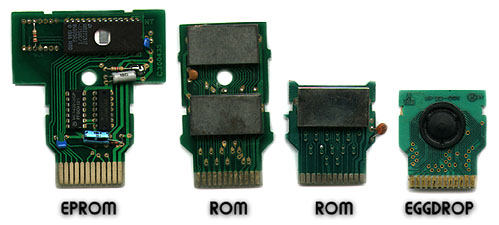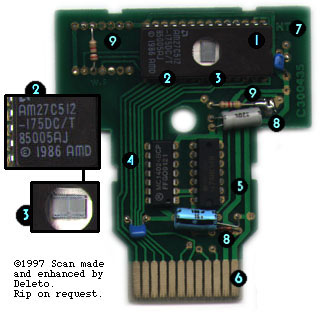
 m o r e
m o r e

So you want more? Pictured here are a bunch of different ROM types.


With the help of Dan Boris, we analysed the second one in the row, an EPROM holding 32 in 1 by Atari Inc, 1988 (CX26163). It was found on a fleamarket and the origin is unknown as well as why (this) 32 on 1 is on an EPROM and how it came there. But it made a decent scan to analyse.
1. 64K EPROM chip 2. Chip identification numbers 3. The actual IC chip as seen through the erase window 4. Binary counter IC chip 5. Inverter IC chip 6. Card edge connector 7. Printed Circuit Board (PCB) 8. Capacitors 9. Transistors
You can see this is a 64K chip by the first number (2): "AM27C512". AM stands for AMD,
the manufacturer, and 512 divided by 8 makes 64K. The other line stands for the speed of the
chip (-175), DIP package (D) and the Commercial Temperature Range (C, the temperature range that
the chip can operate under, in degrees Centigrade. The last number (85005AJ) is the Manufacturer
Date, and states that it was made in 1985. Dates code are different for every manufacturer and they
generally don't make public what they mean.
The IC chip (3) is holding the games (ROM Image). Now the Binary Counter Chip (4) takes care of
counting which game is currently on, and which will be next when you switch the Atari on and off.
The Capacitors (8) store an electrical charge to keep the counter chip "alive" while
the power of the 2600 is cycled. The 2 small blue ones are de-glitching capacitors and help smooth
out the power going to the IC chips. That is all there really is to it.
More ATARI 2600 carts turned inside out and exposed on the
Inside-Out page, and more Die-Hard info on EPROMs and such on manufacturer
AMD's Website: http://www.amd.com/products/nvd/techdocs/techdocs.html